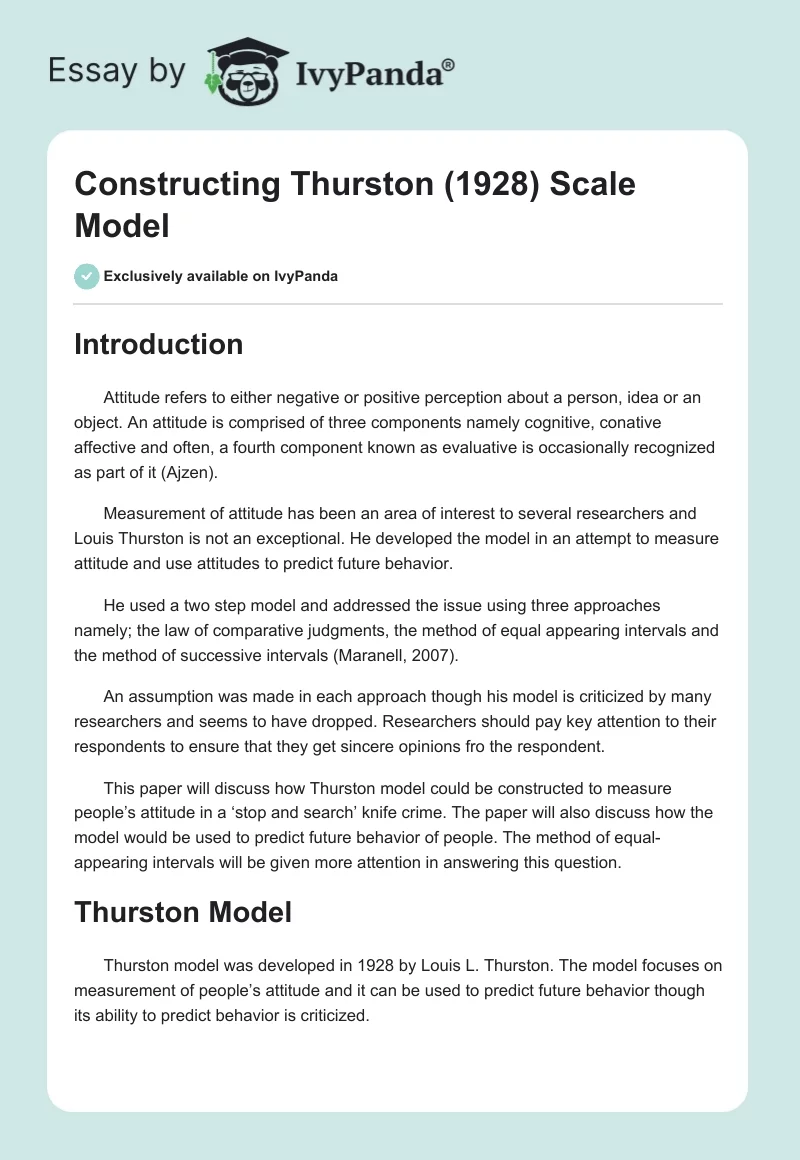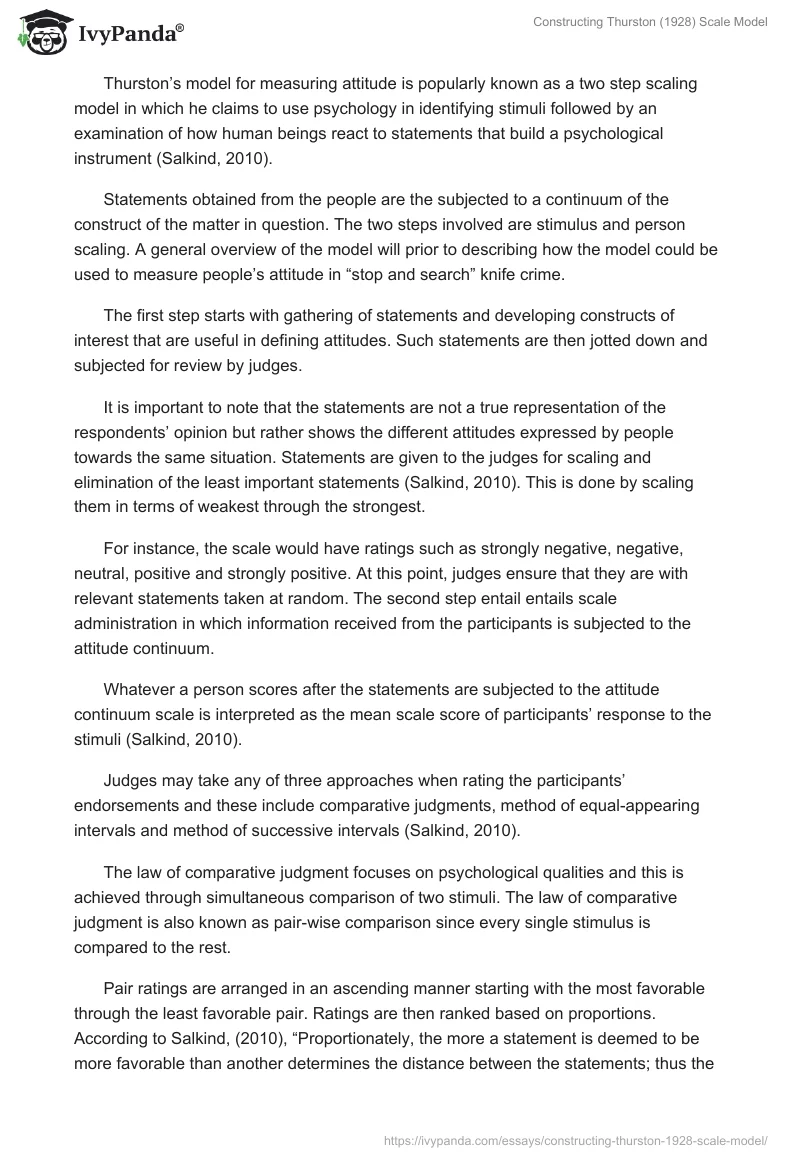Introduction
Attitude refers to either negative or positive perception about a person, idea or an object. An attitude is comprised of three components namely cognitive, conative affective and often, a fourth component known as evaluative is occasionally recognized as part of it (Ajzen).
Measurement of attitude has been an area of interest to several researchers and Louis Thurston is not an exceptional. He developed the model in an attempt to measure attitude and use attitudes to predict future behavior.
He used a two step model and addressed the issue using three approaches namely; the law of comparative judgments, the method of equal appearing intervals and the method of successive intervals (Maranell, 2007).
An assumption was made in each approach though his model is criticized by many researchers and seems to have dropped. Researchers should pay key attention to their respondents to ensure that they get sincere opinions fro the respondent.
This paper will discuss how Thurston model could be constructed to measure people’s attitude in a ‘stop and search’ knife crime. The paper will also discuss how the model would be used to predict future behavior of people. The method of equal-appearing intervals will be given more attention in answering this question.
Thurston Model
Thurston model was developed in 1928 by Louis L. Thurston. The model focuses on measurement of people’s attitude and it can be used to predict future behavior though its ability to predict behavior is criticized.
Thurston’s model for measuring attitude is popularly known as a two step scaling model in which he claims to use psychology in identifying stimuli followed by an examination of how human beings react to statements that build a psychological instrument (Salkind, 2010).
Statements obtained from the people are the subjected to a continuum of the construct of the matter in question. The two steps involved are stimulus and person scaling. A general overview of the model will prior to describing how the model could be used to measure people’s attitude in “stop and search” knife crime.
The first step starts with gathering of statements and developing constructs of interest that are useful in defining attitudes. Such statements are then jotted down and subjected for review by judges.
It is important to note that the statements are not a true representation of the respondents’ opinion but rather shows the different attitudes expressed by people towards the same situation. Statements are given to the judges for scaling and elimination of the least important statements (Salkind, 2010). This is done by scaling them in terms of weakest through the strongest.
For instance, the scale would have ratings such as strongly negative, negative, neutral, positive and strongly positive. At this point, judges ensure that they are with relevant statements taken at random. The second step entail entails scale administration in which information received from the participants is subjected to the attitude continuum.
Whatever a person scores after the statements are subjected to the attitude continuum scale is interpreted as the mean scale score of participants’ response to the stimuli (Salkind, 2010).
Judges may take any of three approaches when rating the participants’ endorsements and these include comparative judgments, method of equal-appearing intervals and method of successive intervals (Salkind, 2010).
The law of comparative judgment focuses on psychological qualities and this is achieved through simultaneous comparison of two stimuli. The law of comparative judgment is also known as pair-wise comparison since every single stimulus is compared to the rest.
Pair ratings are arranged in an ascending manner starting with the most favorable through the least favorable pair. Ratings are then ranked based on proportions. According to Salkind, (2010), “Proportionately, the more a statement is deemed to be more favorable than another determines the distance between the statements; thus the scale emerges through the rating data based on the perceived differences among the entire collection of items, and it is obtained through the complete series of paired comparisons.”
If statistics are applied, individual statement scale value is arrived at through standard errors of the observation and proportions. Based on the fact that the scale is prone to fluctuations by the virtue of the fact that it is an artificial construct, Thurston law of comparative judgment assumes normality.
The second approach is the method of equal-appearing intervals. In this method, stimulus are considered independently and assigned values ranging between1-11(Salkind, 2010).
One side has the least favorable stimuli while the other end is labeled more favorable stimuli. Judgment is based on the ability of the stimuli to portray that future participant has more t less of the quality in question.
Each judge ends up with 11 piles whose intervals appear to be equal in terms of width. Scaling is completed by calculating the median of each stimulus as rated by different judges.
The last approach is the method of successive intervals. This approach is just like the previous one (method of equal-appearing intervals) only that it does not assume equal intervals. This method disagrees with the assumption of equal interval and instead tends to take on the normality assumption.
Salkind (2010) states that, “successive intervals approach begins with the simple proportions of interval judgments for each time. Next, the cumulative proportions of judgment for all items are provided.
These cumulative proportions can then be represented by Z score values via the use of a lookup table to create a matrix of z scores. The z scores in these cells are in effect boundaries of the intervals, and by subtracting the values in adjacent cells, it is possible to estimate interval widths.”
Constructing Thurston (1928) scale
Constructing a scale involves participants who are questioned about their attitudes towards a particular subject which in this case is the use of stop and search in knife crime. Their responses are known as item or stimuli. Thurston’s method of equal opportunity will be used in describing how the scale can be constructed.
Respondents are requested to give their attitudes on the stimuli by either agreeing or disagreeing with the stimuli from which stimuli falling on the extreme end of either side are nullified. (Crano & Brewer, 2002).
Nullified or rejected stimuli are referred to as nonmonotone or non cumulative since their inclusion would distort the final findings by a high degree. The research is expected to design clearly worded and easy to understand items for the participants to respond to.
Ambiguous questions as well as questions likely to take either a rejection or acceptance should be avoided at all cost. Sample items would be; I think a stop and search would be good in a knife crime, a stop and search in a knife crime would irritate participants, a stop and search in a knife crime is unethical, a stop and search in a knife crime would be time consuming.
The second step would be call in a number of judges who would assess each respondents response with primary aim of classifying them as either favorable or unfavorable. Ordinarily an 11-point scale is used within one end labeled as most favorable and the other end labeled as least favorable (Crano & Brewer, 2002).
At this point, judges are not expected to employ their own attitudes but instead they should ensure that the subjective intervals on the scale are equal.
Once the judges are done with their work, the investigator takes it upon him to determine the standard deviation and mean favorability. Large standard deviation is not favored since it implies major disparity on the ratings by the judges. The model assumes that the respondents understand all the items in a similar manner.
However, large standard deviation implies that there was some ambiguity in the item and should therefore be excluded from the list. Attitude scale is then constructed from the number of items remaining whose minimum number should be 15 and should not exceed 25 (Crano & Brewer, 2002).
Thurston’s model in predicting behavior
Thurston’s model ability to predict future behavior has been a controversial issue. The issue has been discussed at length by both psychologists and researchers. However, most of them tend to agree that use of attitudes to predict behavior can not be relied on due to the reasons given below.
Many researchers believe that the responses given by the respondents are biased. It is argued that some respondents do not give their true or real opinion. Some people give socially acceptable opinions or are influenced by other factors. According to Ajzen, “The methods available to avoid social desirability bias were of two types.
Disguised procedures of a verbal nature, such as Hammond’s (1948) error-choice technique or Wally and Cook’s (1965) plausibility technique, were based on the assumption that when the purpose of the instrument is not apparent, respondents are less likely to distort or falsify their answers to attitudinal inquiries (for a recent version of the plausibility technique, see Saucier & Miller, 2003).
Alternatively, physiological reactions (e.g., galvanic skin response, heart rate, palmer sweat, or pupillary dilation and constriction) were assumed to prevent bias by assessing involuntary responses over which the individual has little or no control (for a review, see Kidder & Campbell, 1970).”
Multidimensionality of attitudes is another major area of concern with regard to using Thurston’s model to predict future behavior. The model uses a single score to deduce a respondents overall attitude towards the object in question (Ajzen). Psychologists and researchers believe that an attitude construct is more complex and as such, the single score approach was inadequate.
According to Ajzen an attitude has three components namely; cognitive, conative and affective. It is argued that the single score deals with only the affective component. If attitudes were to be used to predict future behavior, then analysis of the conative component would be better placed for analysis.
Conclusion
Louis l Thurston developed the Thurston model in 1928. Thurston attempted to measure people’s attitude and hoped that these attitudes could be used to predict future behavior.
Three approaches were used and they include the law of comparative judgment which is also known as the pair-wise comparison, method of equal-appearing intervals and method of successive intervals. An assumption that attitudes can be used to predict behavior has been challenged on the basis of information bias and multi-dimension or complexity of the attitude construct.
References
Ajzen,I. The Influence of Attitudes on Behavior: University of Massachusetts at Amherst. Web.
Crano,W., & Brewer,M. (2002).Principles And Methods Of Social Research Inquiry and Pedagogy: Across Diverse Contexts Series. NY, Routledge.
Maranell, G. (2007). Scaling: A Sourcebook for Behavioral Scientists. NJ, Transaction Publishers.
Salkind, N. (2010). Encyclopedia of research design. Thousand oaks: California, SAGE.


